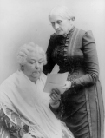
Susan B. Anthony (standing) and Elizabeth Cady Stanton were leaders in the struggle for women's rights.
Before 1970, women's history was rarely the subject of serious study. As historian Mary Beth Norton recalls, "only one or two scholars would have identified themselves as women's historians, and no formal doctoral training in the subject was available anywhere in the country." Since then, however, the field has undergone a metamorphosis. Today almost every college offers women's history courses and most major graduate programs offer doctoral degrees in the field.
The Women's Movement
Two significant factors contributed to the emergence of women's history. The women's movement of the sixties caused women to question their invisibility in traditional American history texts. The movement also raised the aspirations as well as the opportunities of women, and produced a growing number of female historians. Carroll Smith-Rosenberg, one of the early women's historians, has remarked that "without question, our first inspiration was political. Aroused by feminist charges of economic and political discrimination...we turned to our history to trace the origins of women's second-class status."
New Social History
Women's history was also part of a larger movement that transformed the study of history in the United States. "History" had traditionally meant political history – a chronicle of the key political events and of the leaders, primarily men, who influenced them. But by the 1970s "the new social history" began replacing the older style. Emphasis shifted to a broader spectrum of American life, including such topics as the history of urban life, public health, ethnicity, the media, and poverty.
The Personal Is Political
Since women rarely held leadership positions and until recently had only a marginal influence on politics, the new history, with its emphasis on the sociological and the ordinary, was an ideal vehicle for presenting women's history. It has covered such subjects as the history of women's education, birth control, housework, marriage, sexuality, and child rearing. As the field has grown, women's historians realized that their definition of history needed to expand as well – it focused primarily on white middle-class experience and neglected the full racial and socio-economic spectrum of women.
Women's History Month
The public celebration of women's history in this country began in 1978 as "Women's History Week" in Sonoma County, California. The week including March 8, International Women's Day, was selected. In 1981, Sen. Orrin Hatch (R-Utah) and Rep. Barbara Mikulski (D-Md.) co-sponsored a joint Congressional resolution proclaiming a national Women's History Week. In 1987, Congress expanded the celebration to a month, and March was declared Women's History Month.



